September 3, 2025
In the pest control business, acquisition costs pile up fast, including door-knocking campaigns, online ads, and seasonal promotions; all of it burns cash if those customers never return.
That’s the point where retention really makes a difference. When done right, retention safeguards your margins and strengthens your customer relationships. It makes recurring billing a default, not a goal.
Yet, most pest control operators remain focused on chasing new leads, often overlooking the hidden goldmine in their existing customer base. The truth is, retention delivers its best results when backed by a structured, software-driven approach rather than scattered, manual efforts.
This is the point where pest control business software becomes indispensable. It transforms follow-ups, rebooking, and service reminders into an automated, seamless process.
Client Retention Tips for Pest Control Companies Using CRM
Retention is no longer just a buzzword; it’s now actionable, measurable, and profitable, fueled by insights, intelligent dashboards, and a system designed to foster repeat business.
Let's explore why traditional methods often fall short at scale and how modern operators utilize pest control software to establish a reliable rebooking system.
You’ll learn how CRMs like PestBase drive long-term value through automated follow-ups, precise service reminders, and intelligent customer relationship management.
This blog explains how to secure repeat business using structured systems, rather than scattered tactics.
Key Takeaways:
- Retention drives profitability. It costs less than acquisition and builds long-term value.
- Most pest control companies lose customers due to missed follow-ups, ineffective reminders, or inconsistent outreach.
- Manual tactics don’t scale. Sticky notes and phone calls fall apart once the client base grows.
- A pest control CRM like PestBase makes retention systematic, not guesswork.
- With automated follow-ups, smart service reminders, behavior-based campaigns, and churn alerts, PestBase keeps clients engaged and coming back.
What Causes Pest Control Customers to Leave?
Wondering why your top customers choose your competitors? Let's find out!
I. Missed Follow-Ups Break Trust
Late communication signals a decline in effective customer relationship management. When customers hear nothing after the sales funnel, they assume the relationship ended with the invoice.
II. Delays Invite the Competition
Slow or inconsistent scheduling creates an opening for another competitor. If the customer waits too long, someone else fills that gap.
III. No Reminders, No Rebookings
Most clients won’t remember their last service date. Without timely nudges, they often forget or opt for the next available office or field operations.
IV. No Service History Means No Context
Rebookings rely on context based on contract project sites or batch customer communications. When teams lack visibility into past visits, treatments, or notes, they miss the opportunity to reconnect with customers.
Discover why spreadsheets might be holding your pest control business back.
What Keeps Pest Control Customers Coming Back?
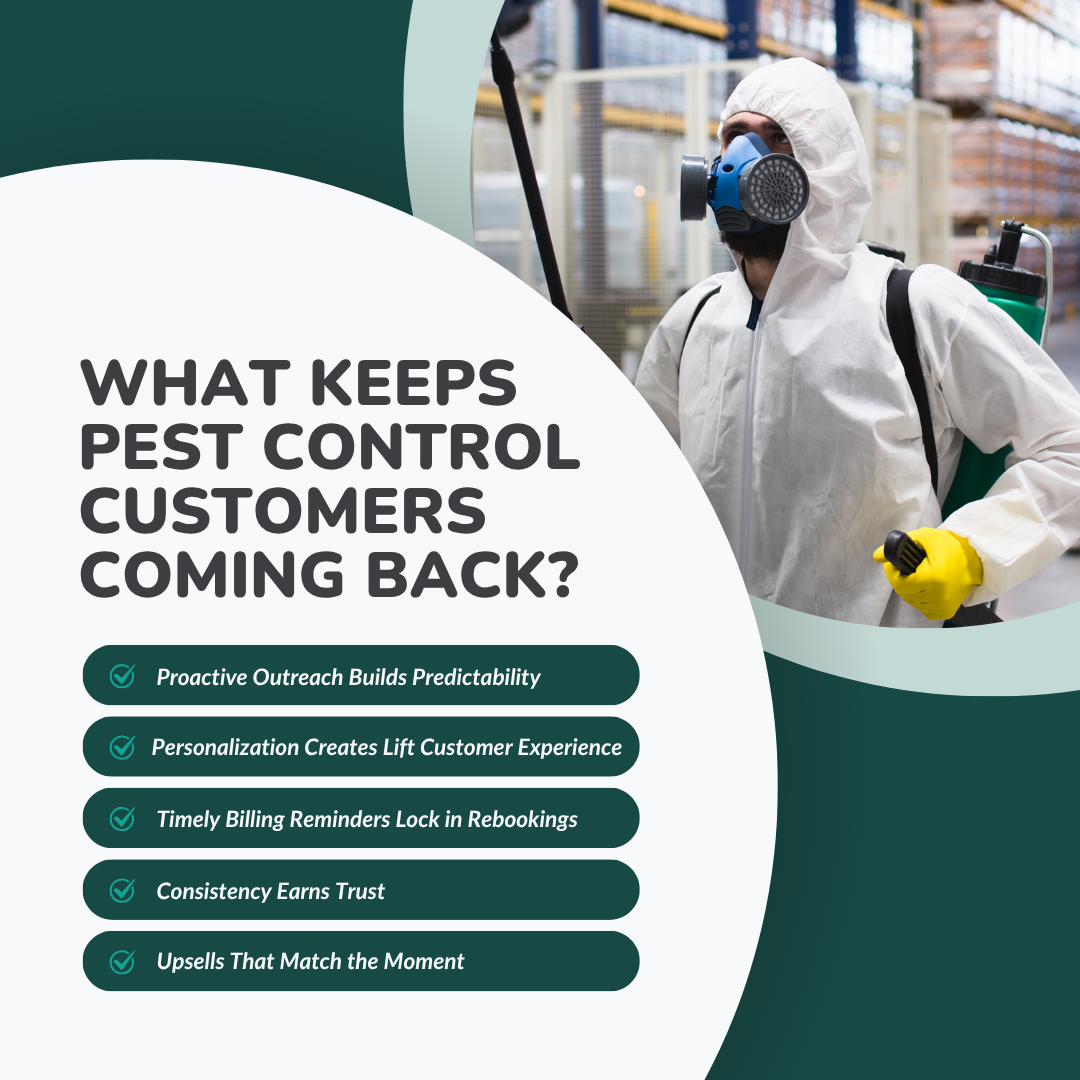
Retention doesn’t happen by accident. It’s built through structure, timing, and relevance.
1. Proactive Outreach Builds Predictability
Customers value control. When your team checks the customer portal in before they need to ask, it signals reliability. That alone sets your pest control service apart.
2. Personalization Creates Lift Customer Experience
The customizable message center uses first names, local pest patterns, and recent history. Customers respond well when the message feels personalized to them, rather
than wasting time on irrelevant pest control business information.
3. Timely Billing Reminders Lock in Rebookings
A billing reminder two weeks in advance keeps the schedule full. Miss the window, and the customer moves on. Consistent, well-timed nudges protect routes.
4. Consistency Earns Trust
Showing up on time every time does more than just complete the job. It builds trust. Reliability leads to retention.
5. Upsells That Match the Moment
Add-ons should solve problems, not inflate invoices. When timed right and rooted in customer satisfaction, upgrades feel helpful. The customer leans in.
See how PestBase CRM easily handles everything from first inquiry to confirmed booking!
Common Retention Tactics (and Why They Fail Without Tech)
Most pest control businesses care about retention. The intent is there. The follow-through often happens in bits and pieces: a text here, a call there, maybe a thank-you card after the first job. It feels personal, and sometimes it works.
However, over time, these scattered efforts tend to stall. The more your customer number grows, the harder it becomes to keep up.
A. Handwritten Cards and One-Off Messages Lose Steam
In the early days, writing a personal note or firing off a custom text felt right. You want to show the customer they matter. And they do.
However, when you reach 50, 100, or 300 clients, you run out of bandwidth. The cards stop. The messages get delayed. Clients notice the drop in effort.
B. Occasional Check-Ins Feel Disconnected
You call in April to see how things are going. The client hasn’t heard from you since October. They barely remember the service. That call now feels like a sales pitch, not a value-added service. Retention depends on rhythm. Random check-ins miss the mark.
C. Manual Outreach Kills Consistency
When reminders are written on a whiteboard, a calendar app, or stored in someone’s head, things slip. Customers get skipped. Follow-ups are not conducted accurately and effectively.
D. No Records of Customer Information
With paper records, your team has no clear visibility into what’s working. You don’t know which messages drive rebookings. You can’t see which clients are going cold.
You’re guessing. And guessing doesn’t scale.
Now let's move on to the solution! You just need a CRM that's built specifically for your business!
What Is Pest Control CRM Software?
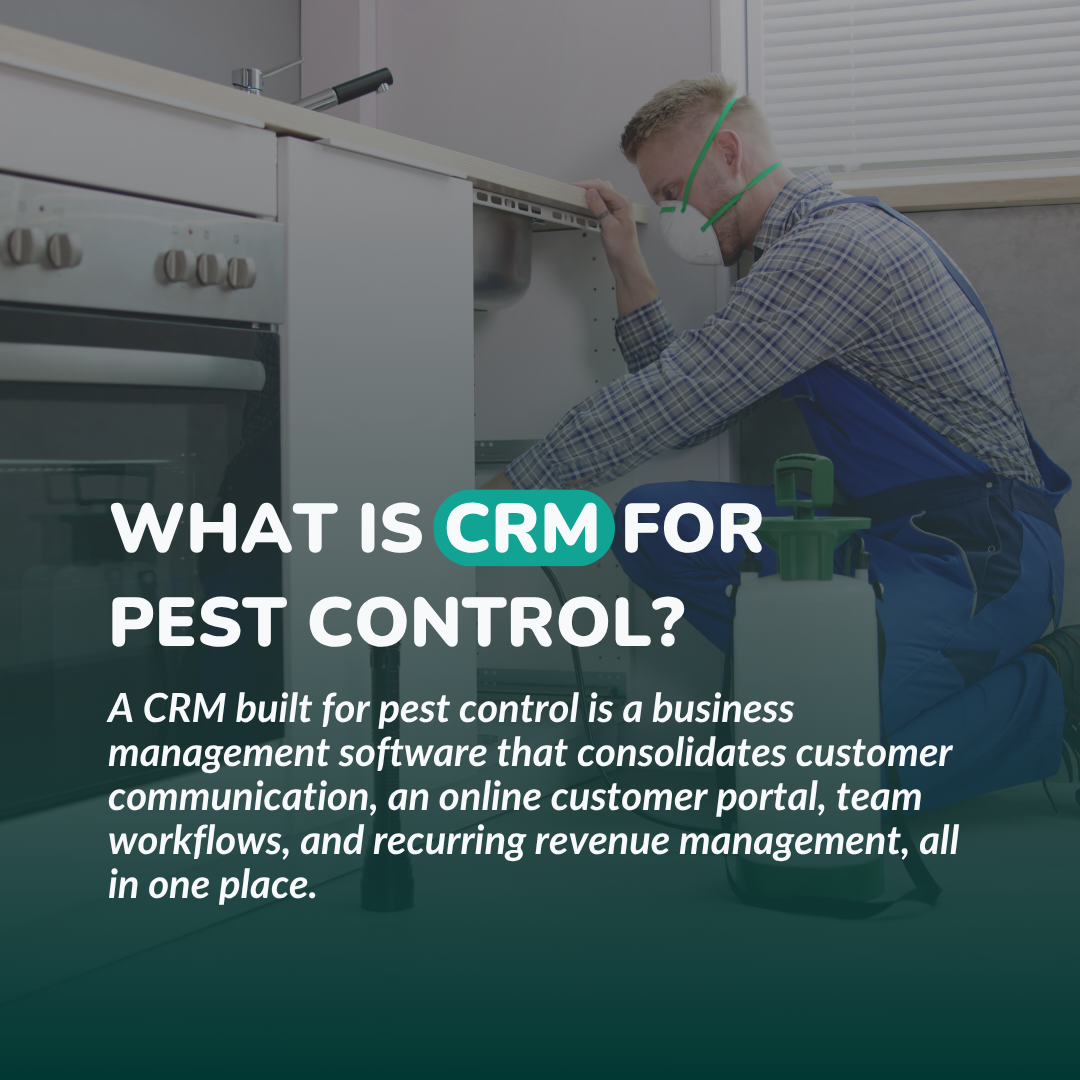
A CRM built for pest control is a business management software that consolidates customer communication, an online customer portal, team workflows, and recurring revenue management, all in one place.
It replaces scattered notes, calendar apps, and manual follow-ups with automation that runs clean, fast, and on time. A new study revealed that 30% of field service
Firms increased customer retention by using a CRM.
This isn’t just contact storage. It’s retention infrastructure.
Why It Matters?
- Clients rarely leave after a poor field service experience. They leave when the business goes quiet.
- No follow-up. No reminder. No sign you remembered them. That silence feels like neglect.
- A CRM keeps the connection alive. It sends the thank-you before they expect it. It reminds them before they even think about calling someone else. It helps your team show up with context, every time.
- This kind of consistent follow-through fosters trust. Once trust is established, customers return. Retention then becomes a reliable system rather than a matter of chance.
Searching for a CRM? Discover the top pest control software solutions for small businesses.
How Pest Control CRM Powers Smarter, Scalable Retention?
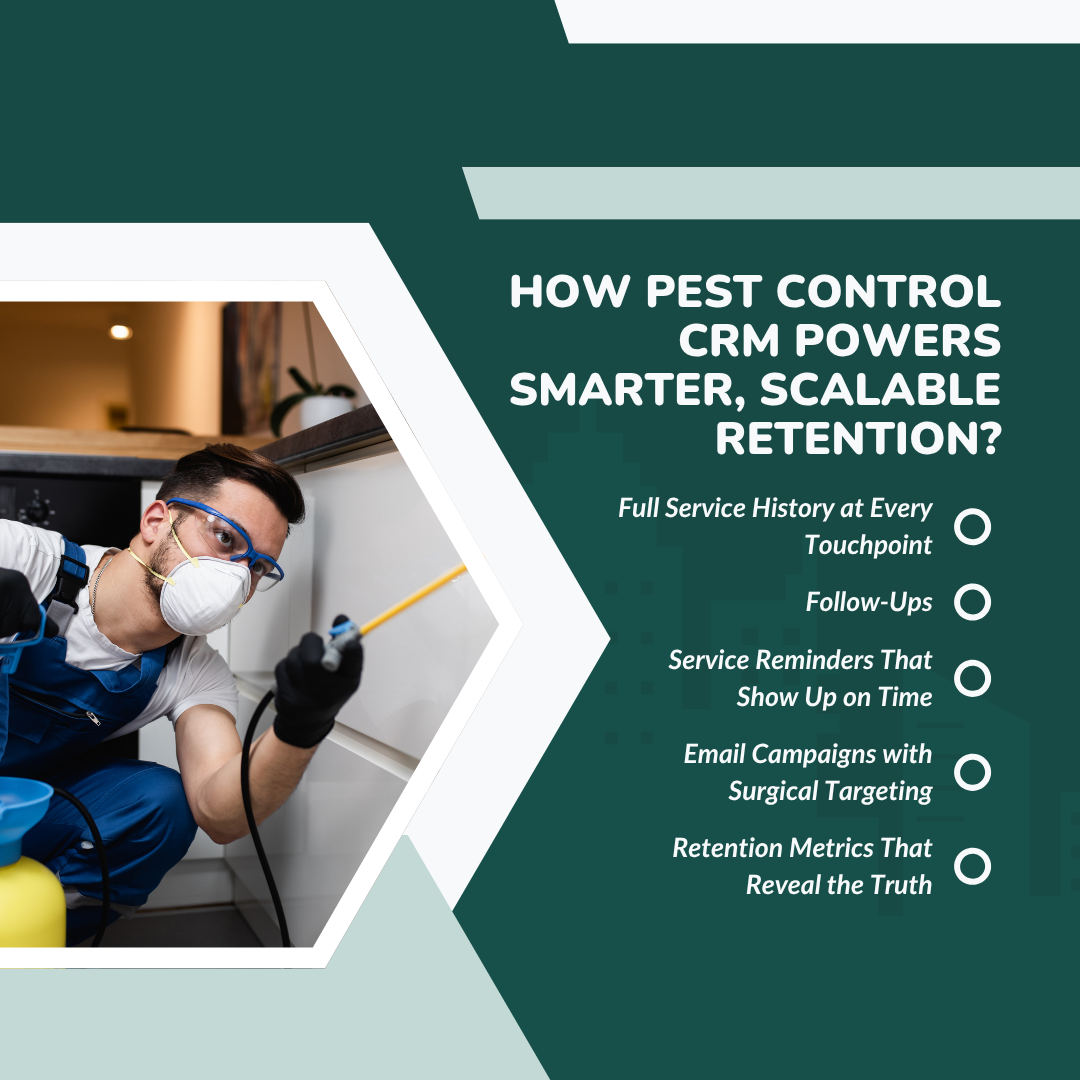
Retention works when the system behind it runs clean. A pest control CRM turns repeat business into process, not luck. It removes friction, closes gaps, and makes customer retention a trackable and repeatable process.
Here’s how the right CRM locks in long-term value:
1. Full Service History at Every Touchpoint
Every customer's information, job, note, photo, and tracking device is logged and visible in seconds. The tech knows the last treatment.
The office operations see the context. The customer gets follow-up that feels precise, not generic. That kind of visibility earns trust and keeps clients returning.
2. Follow-Ups
Manual reminders often fall apart quickly without effective task management. With CRM, it’s a thank-you message, review request, or rebooking offer sent on time.
The communication remains consistent and continues to grow even after the sales funnel.
3. Service Reminders That Show Up on Time
Clients rarely track their customer lifecycles. A CRM handles this with pre-scheduled SMS and email nudges.
Before the next quarter begins, the customer receives a reminder. Their slot gets booked. Your calendar fills before you have to ask with quick and accurate sales management.
4. Email Campaigns with Surgical Targeting
No mass blasts in the pest control business. A CRM segments your list by field service zone, sales team issue, season, and booking history.
You can send monsoon termite alerts to one group, while another gets a spring roach prevention tip. The message lands because it’s specific.
5. Retention Metrics That Reveal the Truth
A gut feeling doesn’t scale a marketing strategy. A CRM shows you who rebooks, who doesn’t, and how fast follow-ups convert.
You can track reservice rates, time gaps, and share service reports. That level of data turns guesswork into increased sales.
Some key metrics of using CRM in the pest control business:
| Metric | Typical Outcome with CRM |
|---|---|
| Average Client Retention Rate | 75–87% |
| Increase with CRM Adoption | +6% retention, –5% churn |
| Operational Efficiency | +25% |
| Profit Boost (from 5% higher retention) | Up to 95% |
Find out the top 5 Exterminator Software for your business!
Retention Tactics That Work (When Fueled by CRM) :
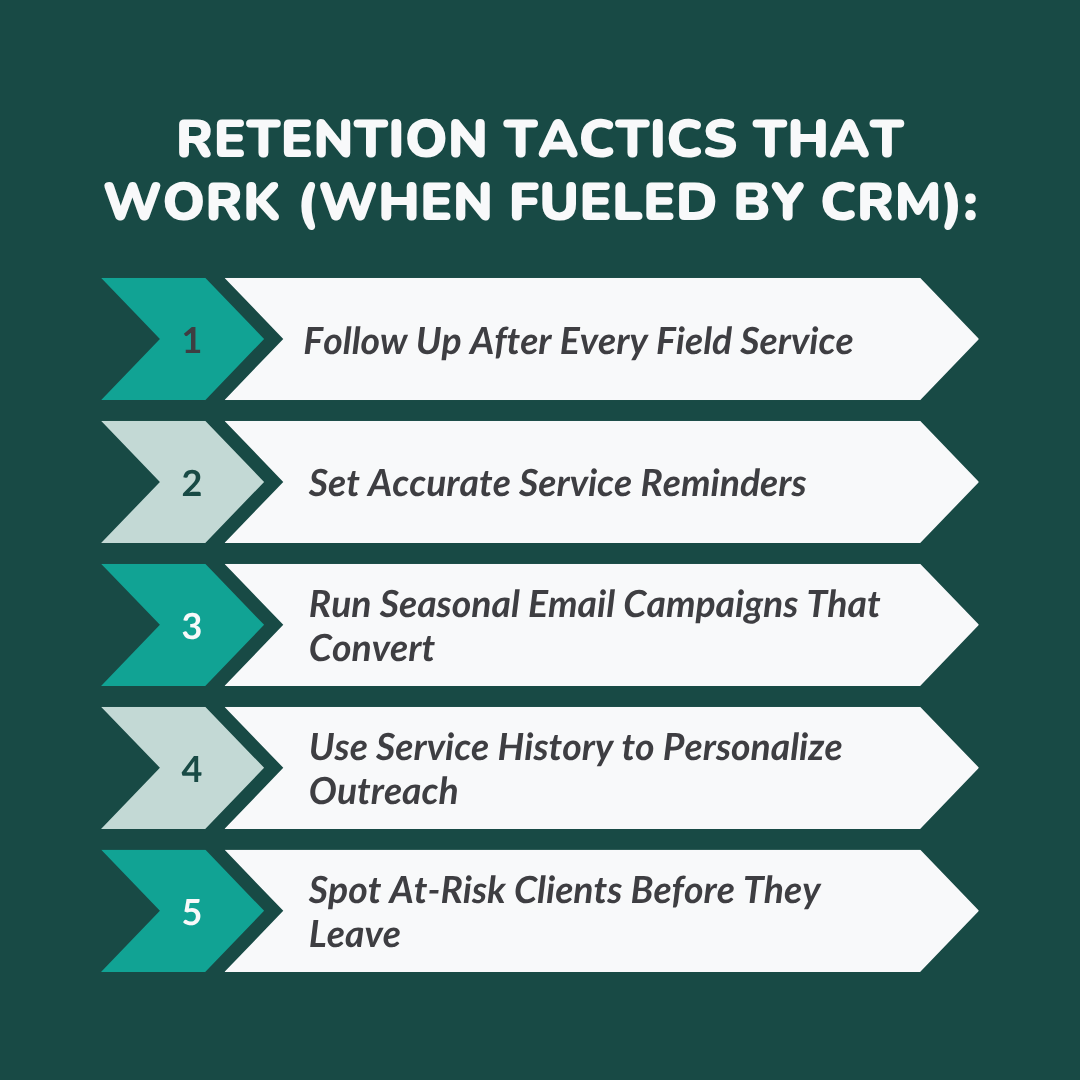
Tip #1: Follow Up After Every Field Service
A completed job isn’t the end. It marks the beginning of retaining existing leads and attracting new customers.
The first 48 hours after service are the most critical. That’s when trust either strengthens or fades. A brief thank-you, check-in, or review reminder shows you care about your clients and that they’re satisfied with their experience.
Manual follow-ups work for a few clients. Then they fall apart. Sticky notes pile up. Messages get delayed. Some clients get missed entirely. With CRM, the follow-up happens on schedule every time. You set the rule once for customer communication, and the customer portal system handles the rest.
Tip #2: Set Accurate Service Reminders
Customers often forget how quickly life can get busy. It’s easy for pest reminders to slip out of mind until they suddenly resurface in a bigger way.
Smart reminders fix that. When a customer is due for quarterly or annual service, the CRM sends a message that feels timely, not intrusive. The tone stays helpful. The timing lands just right.
These nudges aren’t just about convenience. They protect rebookings, keep routes full, and reduce gaps in recurring revenue by reminding them about the online payments flexibility option.
Example Message:
“It’s been six months since your termite treatment. Want us to inspect the property before the season shifts again?”
Tip #3: Run Seasonal Email Campaigns That Convert
Clients ignore generic promos. They open emails that feel relevant. That starts with timing and targeting.
Seasonal campaigns are your best shot. Share helpful tips for monsoon pests. Offer early booking for winterproofing. Adjust flag changes in service hours or pricing before the peak season arrives.
Verify your list by location, pest type, or past services. Keep it short. Make it useful.
Tip #4: Use Service History to Personalize Outreach
Generic outreach feels lazy. Customers respond when the message shows you remember their last issue with pest control.
That starts with service history. A good CRM like PestBase provides your team with instant access to past treatments, technician productivity, and scheduling information.
You know precisely what was done and when.
Now the follow-up feels intentional. You can offer re-treatments, upgrades, or seasonal check-ins that match their field service requirements.
Tip #5: Spot At-Risk Clients Before They Leave
Retention starts with real-time data visibility. If you wait until a customer disappears, it’s already too late.
CRM site analytics show you who hasn’t rebooked in 3, 6, or 12 months. These quiet gaps often signal potential customers and prompt businesses to collect their data and automate appointments. Smart teams act before that happens.
Set safety regulations and alerts for inactivity. Create win-back offers. Reopen the conversation with collected data, rather than discounting spam.
Example Action:
“Hi James, it’s been a while since your last mosquito treatment. We’re in your area this week. Want us to stop by?”
Discover the key differences between Pest Control Software and Manual Scheduling and find out why it really makes a difference for your business.
Meet PestBase: CRM Built for Pest Control Companies
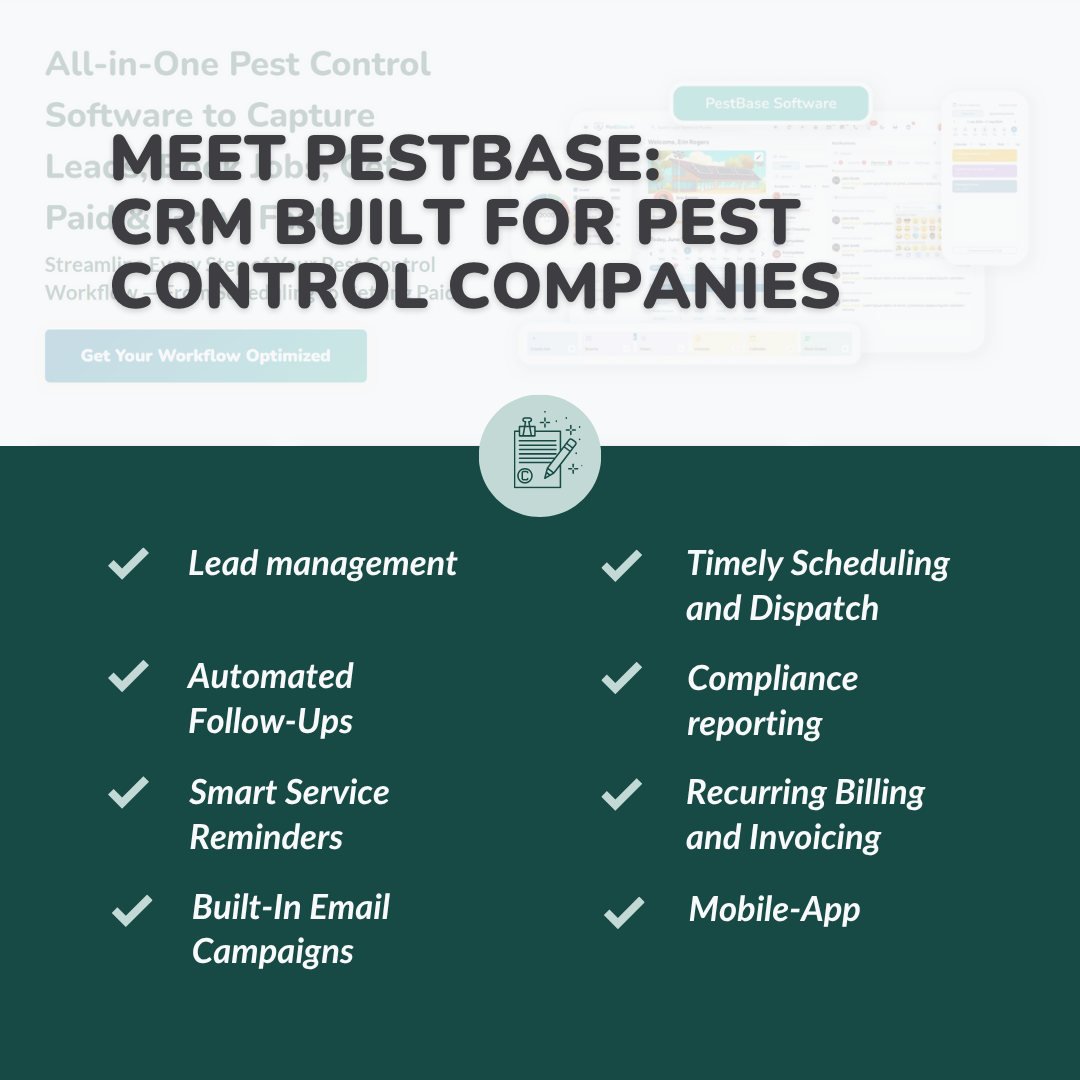
Most CRMs weren’t made for your kind of office management work. They hinder your sales team's productivity with task management and lead management.
PestBase wasn’t designed to store contacts but to enhance a high customer experience. Every feature advances client communication tools, streamlines field operations, and automates appointments with CRM capabilities.
1. Lead management
Every treatment, photo, note, invoice, and technician visit is tracked in one clean timeline. Whether a customer calls in or your tech checks in, the context is always ready. No missed details. No blind spots.
2. Automated Follow-Ups
After each visit, PestBase triggers personalized follow-ups. Thank-yous. Review requests. Upsell offers. You set the rules once, and it attracts potential leads, helping to convert them into new customers. This results in higher rebooking rates without requiring additional administrative work.
3. Smart Service Reminders
PestBase schedules timely SMS and email reminders before the service due date. The system looks at each client’s treatment cycle and nudges them at the right moment. Meaning fewer drop-offs and more consistent recurring appointments.
4. Built-In Email Campaigns
Run seasonal, regional, or pest-type-specific email campaigns. Drag-and-drop tools connect directly to customer data. This way, emails feel focused, timely, and relevant, not spammy.
5. Timely Scheduling and Dispatch
Live calendars. Mobile tech views. Job routing. PestBase replaces the whiteboard chaos with smooth, trackable workflows. This results in fewer missed visits, more efficient routes, and enhanced team coordination.
6. Compliance reporting
The system flags at-risk clients who haven’t rebooked in field barcode production from multiple locations in a set timeframe. Retention dashboards show who’s slipping and why. So you act early, before churn turns into revenue loss.
7. Recurring Billing and Invoicing
Just set it up once and then relax, because it's taken care of. PestBase handles automated billing for recurring clients. Invoices go out on time, every time. Clean cash flow. No manual reminders or late payments.
8. Mobile App
Techs log service notes, upload digital signature images, and mark jobs complete straight from their mobile app. Admin sees it live.
Outcome: Instant updates. Better team alignment. Stronger customer records.
Final Thoughts:
Retention isn’t random: it’s a system! Loyal customers don’t stick around a company or a new business by chance. They stay because you show up on time, with context, and with care.
Manual follow-ups stall. Reminders get missed. Opportunities slip. A good software like PestBase helps you build the structure for repeat business.
Lead flow fuels revenue growth. Retention ensures it stays established.
Want to Retain More Clients Without the Manual Chase?
PestBase makes retention a system: consistent, automated, and built just for pest control.
Schedule your demo today, and let's work together to keep every client you've earned.
FAQs
Q.1 What is the best pest control software?
The best pest control software is the one built specifically for how pest control teams work. It should automate follow-ups, handle service reminders, manage rebooking, and align office and field teams in real time.
Q.2 How much is the charge for a pest controller?
Price determination depends on job urgency, pest type, and service frequency. One-time pest control costs range from $100 to $600, depending on the pest and the severity of the infestation. Heavy infestations may cost more.
Q.3 What is the best way for successful pest control?
Effective pest control relies on a mix of prevention, timing, and effectiveness. It involves targeting the right pest in the right manner at the appropriate stage of its life cycle.
